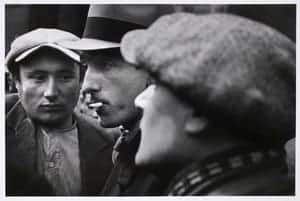1945 – 1970
Although a large number of European artists fled to America to avoid Hitler’s rampage on “degenerate artists” that resulted in the internment of artists at concentration camps, there were artists that remained behind. Influenced by the ravages of war on their homelands, their work in expressionist modern styles showed the inner turmoil of processing the tragedies of the Second World War – which resulted in Postwar European Art
Postwar European Art Origins and Historical Importance:

In the wake of the war, intellectuals, writers, artists, and others had become cynical about the nature and purpose of humanity and questioned the existence of God. Existentialism and atheism took root and people turned to the writings of Kierkegaard, a Danish philosophical theologian and Jean-Paul Sartre, a French author. These men wrote of the existential and Sartre attempted to explore the question of man’s path in a world without God. This angst fostered pessimism in an already depressed era. The art of the period reflects the anguish of the artists mind and soul against the backdrop of a world going through hardship and change.
Most Post War conversations about art weigh heavily on discussing the movements happening in the United States, and it is tempting to think that the Europeans and Americans residing in New York should be credited with all Post War innovation. However, artists remained in Britain and were little exposed to the emerging artists of the US. Even though the New York School started to hit stride following the war, England didn’t hear of any of it until the late 1950s. Yet, England had its own piece to say and ingenuity and new forms of expression were found by its native artists.
“On occasion I have drawn as a release from painting. The economy in using paper, pencil, charcoal and crayon can help towards a greater gamble and higher rewards. I also find that drawing can generate ideas more rapidly than painting”. – William Scott
William Scott was interested in abstraction but he broke ground with taking a simplistic and harmonious approach to it rather than the chaotic tension happening elsewhere and he went against convention by letting figures appear so clearly. His goal was to explore the color and shape and his subject matter was secondary. The objects of his painting were often pots and pans and his paintings are somewhat comforting, and possibly even amusing in feel. With these simplistic arrangements and treatment of colors, Scott brings an abstract still life that is soothing to look at and instills a sense of calm, something unusual for abstract art to that time.

Photography played an important role in art during the Post War period, and with as the accessibility and portability of cameras and their equipment became more convenient and less expensive, more artists were able to create in this way. The public’s need to see and to understand what had happened and what was happening led to an uptick in the need for printed news that could capture information visually, leading to the proliferation of picture magazines.
With this new need for photographs came a need for the photojournalist, an artistic type not discussed or contemplated on a large scale thus far. Of course, brilliant photographers had existed, but not on such a large scale. They didn’t need just any photographer, they needed one that understood the spoils and the tragedies of war and that understood the human condition through the lens of experience.
“The creative act lasts but a brief moment, a lightning instant of give-and-take, just long enough for you to level the camera and to trap the fleeting prey in your little box”. – Henri Cartier-Bresson
Four photographers, including the famous Cartier-Bresson, formed a company under this demand and their business plan allowed for an art form to emerge that was economically and artistically under the control of the artist rather than the school, patron, or critic. The photography agency they created was called Magnum Inc. and they ran in it such a way that they retained all copyrights to their photos, and that they could grant permission to print a single photograph or that a publication could only print a photograph along with its entire photo essay. Each photographer was assigned a different part of the world, trading back and forth as they were moved to do so. The structure of this agency allowed them to maintain their artistic integrity, values, and styles while reporting world events.

European photography outside of photojournalism was helped along by Otto Steinert when he founded the movement, Subjektive Fotografie, which encouraged the photographer to explore techniques both in the field and in the darkroom to create effects through lighting, depth, focus, and shadow that would imbue meaning in the photograph beyond the realistic recording of the subject at hand.
“I would say that the war correspondent gets more drinks, more girls, better pay, and greater freedom than the soldier, but at this stage of the game, having the freedom to choose his spot and being allowed to be a coward and not be executed for it is his torture”. Robert Capa
Postwar European Art Key Highlights:
- Henri Cartier-Bresson, the father of photojournalism, was an early student of modern art painting. He studied Cubism under Andre Lohte whom he credited as having taught him “photography without a camera.”
- England’s Alan Davies was an extremely famous artist in the 1960s and 70s with an almost rock star like following, but was largely forgotten until recently. He was known for his bright and vivid colors and patterns within abstract objects. His influence can be seen in the graphic art and fashion of the time in England.
Postwar European Art Top Works:
- Still Life with Candlestick – William Scott
- Detail from Emerald – William Scott
- Delicious Doge – Alan Davie
- The Berlin Wall 1963 – Henri Cartier-Bresson
- Workers at the Renault Factory – Robert Capa
[html_block id=”9712″]
[html_block id=”9474″]

